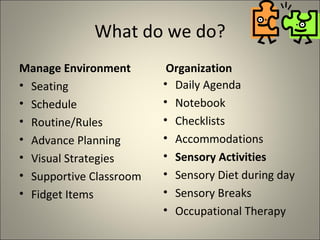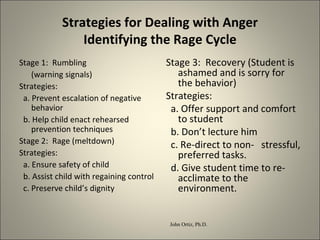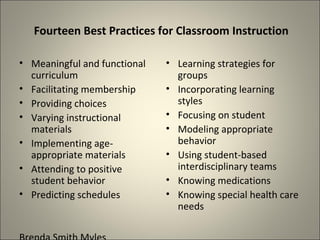Understanding Autism And Meeting The Needs Of Our Students
- 1. Understanding Autism Putting the Pieces Together for a Successful Year with our Students By: Rosalou Maxwell Hoover City Schools 2009-2010 School Year
- 2. Autism Facts Complex Neurobiological Disorder and involves: Qualitative Impairment in Social Interaction Qualitative Impairment in Communication Onset prior to 36 months Restricted repetitive and stereotyped patterns of behaviors, interests, and activities Costs about $3.2 million to take care of an autistic person over his lifetime. (Harvard) 96% of adults with autism in Alabama are unemployed. Prevalence 1:150 Male to Female: 4:1 Theories of Etiology Differences in Brain Environmental Genes Combination of the above, “It could be that the child has a genetic predisposition toward autism that gets triggered by something environmental”. Dr.Simpson, Auburn -New: Impaired regulation of the locus coeruleus, a bundle of neurons in the brainstem that processes sensory signals from all areas of the body.(June ‘09)
- 3. What do you see in Students with High Functioning Autism?
- 4. What do we do? Manage Environment Seating Schedule Routine/Rules Advance Planning Visual Strategies Supportive Classroom Fidget Items Organization Daily Agenda Notebook Checklists Accommodations Sensory Activities Sensory Diet during day Sensory Breaks Occupational Therapy
- 5. Visual Schedules Class Schedule ____DOL ____Reading ____Snack/Break ____Math ____Lunch ____Recess ____Science ____Social Studies Rules for Science Place all your belongings under your desk Raise your hand if you need the teacher’s assistance You may quietly get up and sharpen your pencil
- 6. Relaxation Schedule ____Close my eyes ____Take 2 deep breaths ____Count to 10 ____Squeeze my arms ____Take 2 deep breaths Ask: ___A. Am I relaxed? YES. Then go back to class/work ___B. Am I relaxed: NO ___Then start over again
- 8. Theory of Mind The ability to pick up and act on social assumptions The ability to think about other people’s thinking (Are they interested in what I’m saying ?) Generally have “wrong” perceptions of what others are thinking Mind reading (facial expressions, body stance, voice tones) They may not realize their comments can offend or embarrass others
- 9. Executive Dysfunction Problems with planning, organizing, shifting attention and multitasking Difficulties approaching complex tasks, breaking them down into parts and budgeting time Waste time talking and worrying about a project rather than planning and working on it May lead to losing supplies, forgetting assignments Cannot take notes and listen to the teacher Need to finish one task before beginning a second Unable to leave a task if it is not finished
- 10. Central Coherence The ability to draw diverse information together to construct higher level meaning in context Understanding the “gist” of a story Grasping an underlying theme within a message Seeing parts over wholes Represents both strengths and weaknesses and should be thought of as a cognitive style
- 13. Strategies: -Focus on interest areas for reports/projects -Use interest areas for motivation Give them “rules” to memorize to help them in math Redirect them to talk about something else Use their interests as reinforcement when they complete their work -Make sure they are comprehending what they memorize
- 15. Strategies: Assistive Technology Assessment Use alternate writing accommodations (keyboarding) Use power point projects, creative ways to present , other than writing Limit writing tasks Use fill in the blank/multiple choice
- 17. Strategies: Behavioral Contracts Behavioral Charts (1-5) Relaxation Schedules Self-Management Strategies Be aware of “stressors” (unstructured times, transitions, crowded hallways, changes in schedule, social interactions, P.E., lunch, recess) Positive Behavior Management
- 18. Additional Strategies for Behavior Be generous with praise Be specific about what the student is doing “right”. Use token cards/visual systems to manage behaviors Establish reinforcements/incentives for the students to complete work and to maintain positive behavior. These may change throughout the year. Consult with Behavior Specialist (Functional Behavior Analysis )
- 19. Self-Regulated Calm Down Time Students with autism become easily over stimulated in regular classes which can lead to disruptive behavior They need strategies to “calm down” and to request a “break” before they lose control Give the student possible strategies of things to do and things not to do and teach them to use those Identify a signal or cue to use when either the student or teacher feels a break is needed (Recognize and know student and signs of possible melt down) Student is reinforced for following plan
- 20. Strategies for Dealing with Anger Identifying the Rage Cycle Stage 1: Rumbling (warning signals) Strategies: a. Prevent escalation of negative behavior b. Help child enact rehearsed prevention techniques Stage 2: Rage (meltdown) Strategies: a. Ensure safety of child b. Assist child with regaining control c. Preserve child’s dignity Stage 3: Recovery (Student is ashamed and is sorry for the behavior) Strategies: a. Offer support and comfort to student b. Don’t lecture him c. Re-direct to non- stressful, preferred tasks. d. Give student time to re-acclimate to the environment. John Ortiz, Ph.D.
- 22. Involve the Speech/Language Pathologist Use literal language in explanations or explain more abstract concepts Talk about idioms in class if they come up and explain Talk about one item a day of the “Hidden Curriculum” Strategies:
- 23. Additional Strategies for Language Remember comprehension is not guaranteed Clearly define your expectations, tell the student specifically what you want them to do (i.e. Put the microscope in the cabinet instead of clean up the science lab) Combine verbal instruction with pictures and/or gestures Explain generalities (i.e. If there is a science test on Thursday, be sure the student knows he should start studying before Wednesday night) Be specific with directions (call the student’s name, have the student paraphrase directions) Encourage the student to clarify any direction he does not understand
- 24. Social Issues Poor Coping Skills Difficulty Regulating Emotions Limited Friends Relationships with Peers
- 25. Involve the students in a Social Skills Group with typical peers Select some peers to help in the classroom Utilize social stories to help with situations as they arise Write a story for the first day of school and give to your student at “Meet the Teacher” Write a story for when you are absent and leave in your substitute folder. Other techniques to encourage appropriate social behaviors: Power cards Social scripts Comic Strips, Cartooning Social autopsies Video modeling Story movies Book Clubs Help students to practice social skills in the classroom (helps rewire neural pathways) Strategies:
- 26. Circle Games and Activities Data Processing Birthday Line Height Line Having a Chat Relationship Circles Who Am I? Concentration TV Interview Describe Me Comic Strip Chaos Riddles What’s My Hobby? Getting to Know you Bingo Websites: http://kimscorner4teachertalk.com http:// www.educationworld.com http:// ww.cplrmh.com/icebrakers.html
- 28. Strategies: Use visual methods to teach strategies SOCCSS: Situation-Options-Consequences-Choices-Strategies-Simulation, Developed by Jan Roosa SOLVE: Seek-Observe-Listen-Vocalize-Educate Live out Loud: Talk about the steps you are doing as you solve daily problems: (There is no room to write on the board, I need to erase first)
- 30. Strategies: Provide schedules of your day on the board, on desk, in notebook Give mini-schedules for projects/book reports Help them learn new routines Structure assignments for understanding List steps to complete assignments Be consistent as a team in dealing with behavior
- 31. Additional Strategies for Routines Eliminate power struggles by establishing rules for the class and rules for getting along with peers and for understanding how to do things Give him acceptable things to do in free time Examples of Hidden Curriculum Rules During silent reading, read in your mind, not out loud Use your own supplies and ask if you want to borrow something Raise your hand to ask a question When standing in line make sure there is space between you and your friend
- 33. Strategies: Make accommodations Read and follow guidelines in the student’s IEP Help him to consolidate and organize materials preferably in one notebook Break down assignments Write down assignments, projects in an agenda. (include projected tests/projects/notes to parents) Use time lines Provide study guides Use graphic organizers Monitor group work and make assignments
- 34. Art Project Needs _____Colored Paper ____ Scissors _____Glue _____Markers
- 35. LS Schedule Monday Tuesday Wednesday Thursday Friday 8:00-8:50 Class Class Class Class Class 9:00-9:50 Speech Speech Speech Speech Speech 10:00-10:50 Class/Math Class/Math Class/Math Class/Math Class/Math 11:00-11:50 P.E. P.E. P.E. P.E. P.E. Noon-12:30 Lunch Lunch Lunch Lunch Lunch 12:30-1:00 IWS IWS IWS IWS IWS 1:00-1:30 Class/reading Class/reading Class/reading Class/reading Class/reading 1:30-2:15 OT Social OT Social OT 2:15-2:45 Computer Computer Computer Computer Computer 2:45-3:00 Bus Bus Bus Bus Bus
- 36. Other Practical Ideas I think, You Think, The Solution The Daily Scoop Choice Cards Do More to Learn More On Your Own Timers Circle of Friends Make Unique Interest Work for you Homework Checklist Peer training Listening Time Write assignments in the same place daily Teach key words for assignments: (due date, important, long term project, etc) Complete Student Learning Traits Assessment (Asperger Syndrome and Adolescence)
- 37. Home School Communication Establish “rules” E-mail Daily notes on schedule Student writes notes Teacher signs agenda and adds notes Notification system for changes in schedule/teacher absence Scheduled meetings
- 38. Teacher Communication Team meetings All teachers consistent with behavior plan Advise Special Education teacher of areas for accommodations/ skills needed Consult with related services Advise teacher of social group of areas observed that need special attention during the group
- 39. Fourteen Best Practices for Classroom Instruction Meaningful and functional curriculum Facilitating membership Providing choices Varying instructional materials Implementing age-appropriate materials Attending to positive student behavior Predicting schedules Brenda Smith Myles Learning strategies for groups Incorporating learning styles Focusing on student Modeling appropriate behavior Using student-based interdisciplinary teams Knowing medications Knowing special health care needs
- 40. Top 10 Skills Needed by Students Based on 20 years of research and surveys of more than 8,000 teachers Listening to others Following steps Following rules Ignoring distractions Asking for help Taking turns when talking Getting along with others Staying calm with others Being responsible for their behavior Doing nice things for others Stephen Elliott, PhD. Vanderbilt University, Nashville
- 41. Quotes to Remember “ When you have met one child with Asperger Syndrome, you have met one child with Asperger Syndrome.” Stephen Shore “ They live in OUR world, but in THEIR OWN WAY rather than “in their own world.” “ When I was younger, I didn’t realize that I thought differently; therefore, It didn’t occur to me to ask for help or clarification.” Dena Gitlitz “ If they can’t learn the way we teach them, let’s teach them the way they learn”. Paula Kluth
- 42. Summary “Students with AS/HFA live in a world that is often puzzling and unpredictable to them and, therefore, stressful. In order to help them meet their potential, educators must help these students understand the world around them and provide them with strategies and supports that will foster success and independence.” Simple Strategies that Work by Brenda Myles
- 43. Components of Success Individualization Structure and Predictability Flexibility
- 44. 2009-2010 A Successful Year











































